Volumetric Display Market Size and Trends
Global volumetric display market is estimated to be valued at USD 449.0 Mn in 2025 and is expected to reach USD 2,094.5 Mn by 2032, exhibiting a compound annual growth rate (CAGR) of 24.6% from 2025 to 2032.
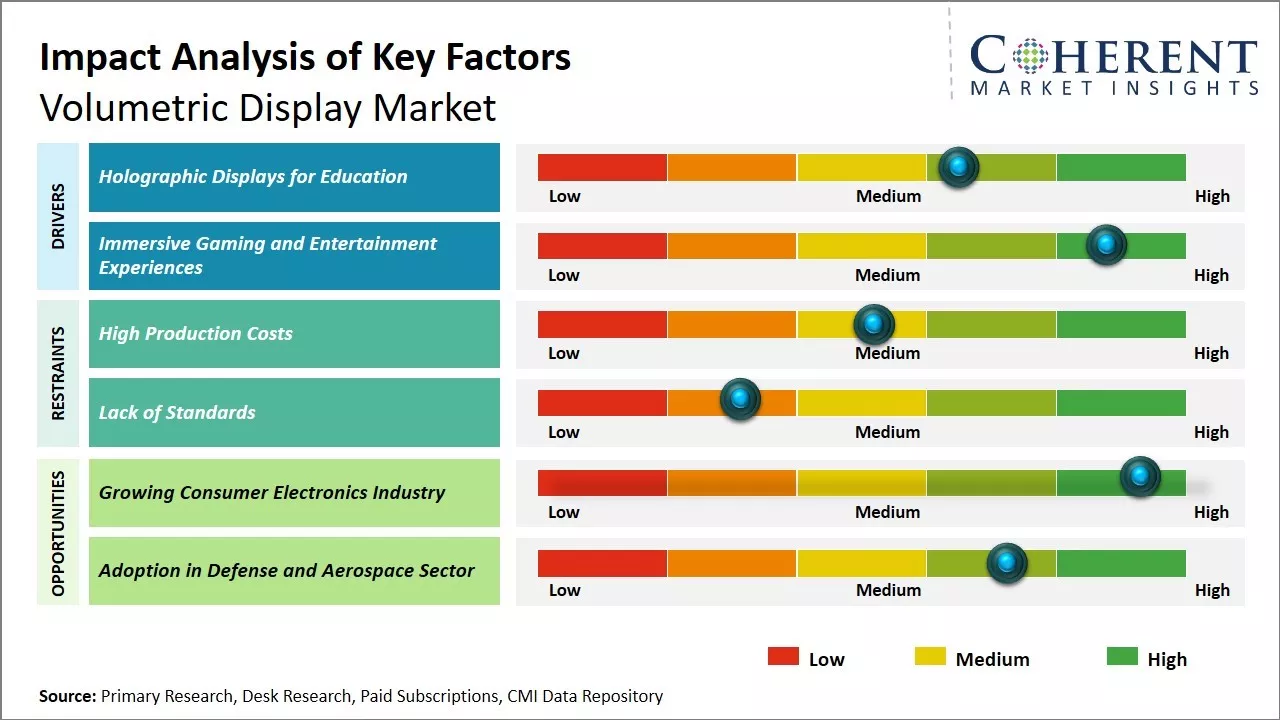
Discover market dynamics shaping the industry: Download Free Sample
Global volumetric display market is expected to witness significant growth over the forecast period due to factors such as advancements in 3D imaging technologies and rising demand from healthcare and medical industries. Volumetric displays are increasingly being used for medical visualization since these provide stereoscopic 3D images of body organs and systems without the need for additional accessories like glasses. Their application in surgical planning and simulation boosts their adoption. With continued technological improvements and declining costs, volumetric displays will likely gain more penetration across multiple industries in the near future.
Holographic Displays for Education
Advancements in volumetric displays bring possibilities for more impactful and interactive educational tools. Three-dimensional holograms and models generated through volumetric display technologies allow visual concepts to be presented and explored from any angle in accurate, true-to-life proportions. Complex scientific and anatomical concepts that are often difficult to grasp in textbooks or on flat screens can be made easier to understand through the use of highly realistic and manipulable 3D renderings. Students will be able to dissect virtual organs, zoom in on microscopic structures, and manipulate virtual simulations in a safe and repeatable manner. This hands-on, experiential learning through holograms has potential to boost student engagement and comprehension across a wide range of educational domains from biology and chemistry to engineering, design, architecture and more. Educational institutions are recognizing value in incorporating emerging 3D display technologies to enhance traditional lecture-based methods. If costs continue decreasing, volumetric displays may become widespread classroom learning tools and change the landscape of education.
Market Concentration and Competitive Landscape
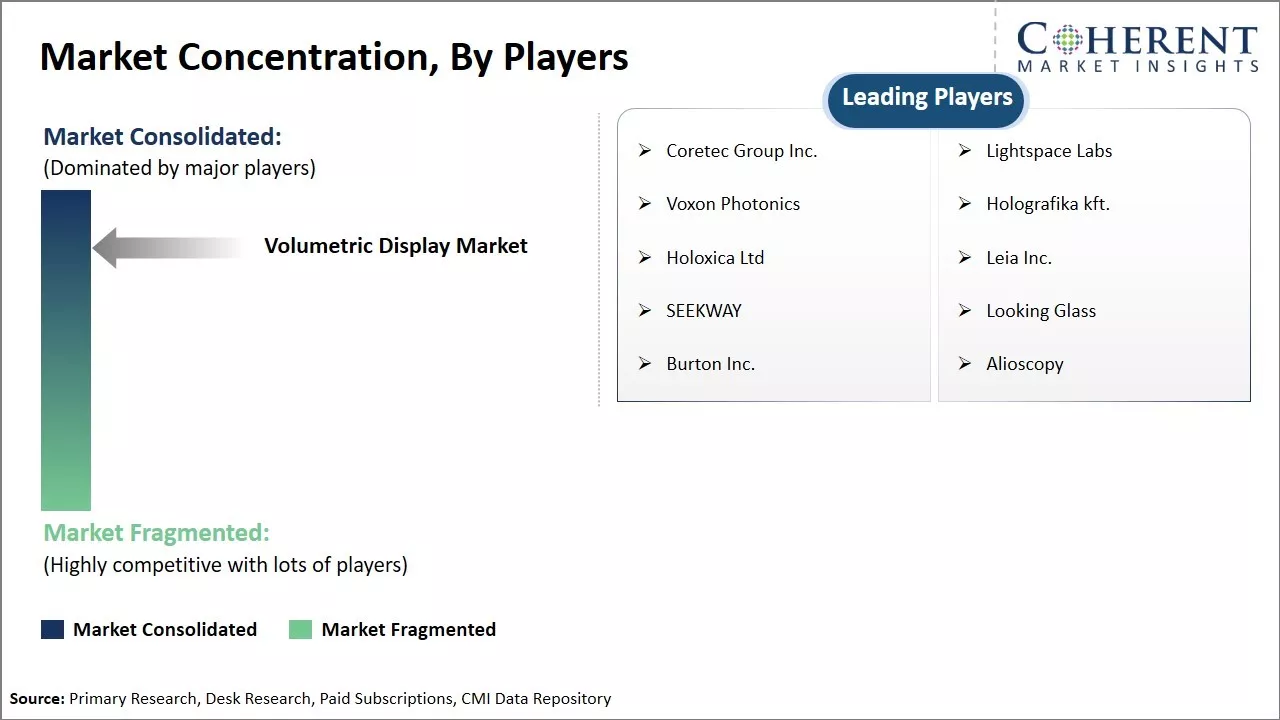
Get actionable strategies to beat competition: Download Free Sample
Immersive Gaming and Entertainment ExperiencesAnother key driver for market growth is popularity of immersive gaming and entertainment experiences demanding highly realistic 3D graphics. As video games continue their ascent into mainstream culture and become more photorealistic, volumetric displays can take gaming to a new level of immersion by generating true 360-degree, multi-perspective holograms that respond instantly to player movement and interaction. This could revolutionize the gaming world beyond flat screens and virtual reality headsets. Similarly, volumetric displays open exciting new possibilities for location-based entertainment like theme parks, arcades, live concerts and sporting events by allowing complex 3D animations, characters and virtual objects to seamlessly coexist with the real world. As audiences expect increasingly captivating multimedia spectacles, the ability to generate naturally lit, obstruction-free holograms without additional viewing apparatuses can boost demand. Movie studios also recognize potential for volumetric displays to enhance special/visual effects and create new formats like "4D" movies. If costs become affordable, these applications could spur mass adoption of 3D holograms for consumer entertainment on a huge scale.
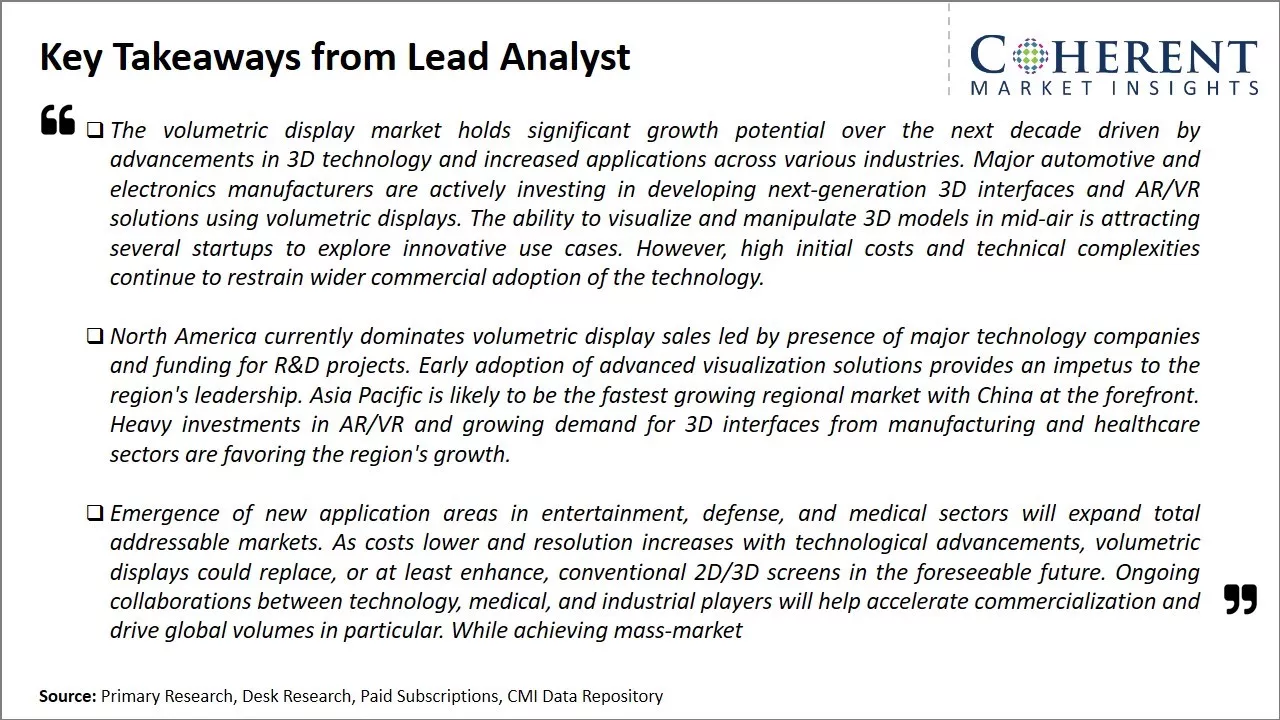
To learn more about this report, Download Free Sample
Market Challenges:High Production CostsGlobal volumetric display market faces several challenges. The core technology is complex which leads to high production costs. The displays currently have low resolutions and brightness levels which impacts visual quality. Additionally, reaching mass markets will be difficult as applications are still niche and consumer demand has yet to be demonstrated on a wide scale.
Market Opportunities: Growing Consumer Electronics Industry
As the technology advances, production costs should decrease which can enable new adoption across more applications and industries. Increased resolutions and brightness will enhance visual experiences and drive broader applications in gaming, medical imaging, and education. Partnerships between technology and content creators can help generate compelling use cases that demonstrate the value of these displays to consumers. Expanding application areas presents the ability to reach mass markets over the long term.
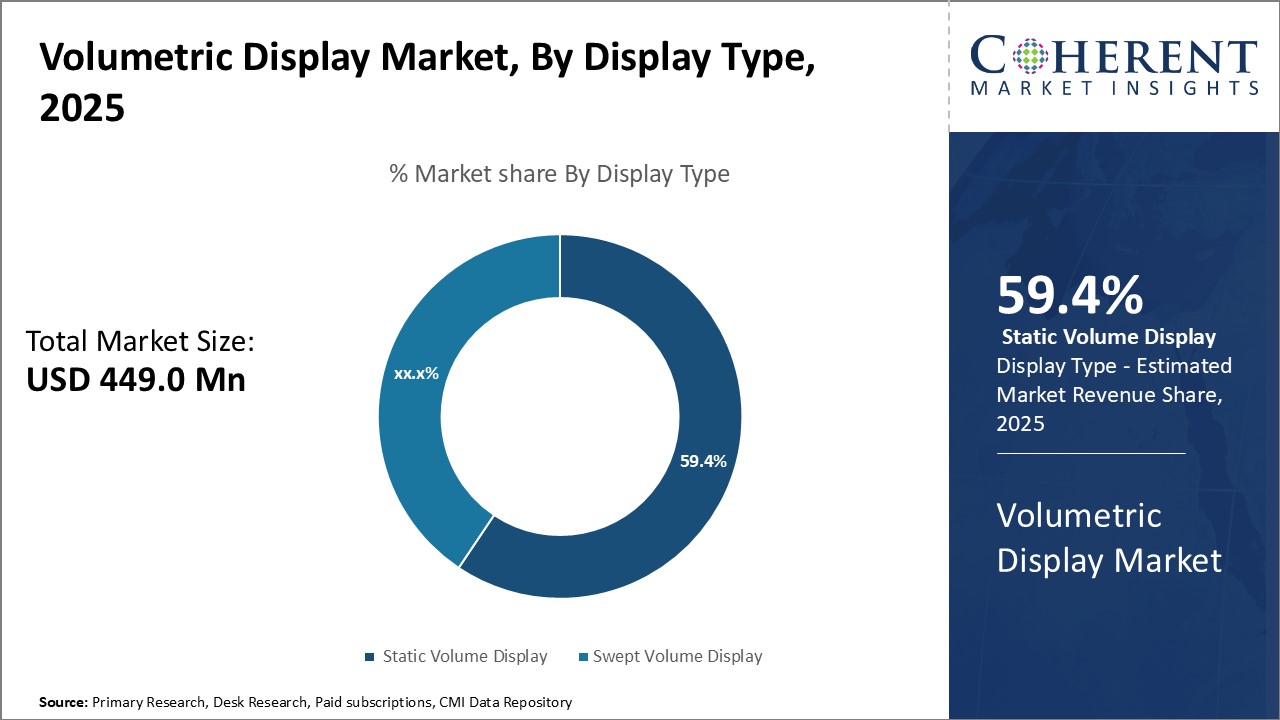
Discover high revenue pocket segments and roadmap to it: Download Free Sample
Insights, by Display Type, static volume display contributes the highest share of the market owing to its superior image quality and stability.Static volume display segment is estimated to hold the largest market share of 59.4% in 2025.
Static volume displays employ various techniques to render images by controlling the optical properties of their display materials. Compared to swept-volume displays that use moving components like DLP chips or laser projectors to generate 3D lightfields, static displays have no mechanically scanning parts. This makes them more robust and reliable for continuous operation over long durations.
Static displays produce imagery of unsurpassed quality due to their ability to simultaneously illuminate all pixels in the 3D lightfield. There are no issues of flickering, motion blur or impaired depthcueing that can occur with mechanically scanned displays. These render sharply defined volumetric objects with consistent brightness and contrast levels. Some techniques also offer ultra-high resolution that surpasses current swept-volume technologies.
The absence of any vibrating components makes static displays virtually maintenance-free. Their fully solid-state design enables rugged form factors suitable for industrial and outdoor use cases. Static displays do not require frequent servicing or downtime for part replacements, ensuring high reliability even in mission-critical applications. Some technologies also boast very low power consumption compared to laser-based swept displays.
Overall, static volume displays have emerged as the preferred solution for applications needing photorealistic 3D imagery as well as robustness, stability and a long operational lifespan. This explain their dominance in the volumetric display market over more transient display types like those based on mechanical scanning. Innovation in static display engineering will likely further cement their leadership.
Insights, by Application - Rising proliferation of medical imaging can drive the medical segment growth
The medical segment is estimated to hold the largest share of 36.1% in 2025 in the volumetric display market due to the growing importance and adoption of advanced medical imaging technologies. Volumetric displays offer notable advantages over traditional 2D and 3D displays for medical imaging applications. These can generate larger 3D imagery that provides better visualization of complex internal structures and anatomical features. This high-fidelity 3D visualization enables more accurate medical diagnoses and treatment planning.
A key driver of growth in the medical volumetric display market has been the expanding use of advanced medical scanning technologies like CT, MRI, ultrasound and PET. As these modalities generate increasingly detailed 3D medical scans, there is a growing need for display technologies that can truly represent this wealth of 3D data. Volumetric displays are uniquely positioned to fulfill this need by visualizing full volumetric medical scans without compromising data resolution or depth cueing. This allows doctors to perceive internal structures, tissues and anomalies in an ultra-realistic manner that closely resembles direct observation during medical procedures.
The medical industry has also seen growing applications of virtual and augmented reality technologies. Volumetric displays integrate well with these environments to generate immersive 3D medical content for applications like surgical simulation, radiology training and patient education. Their realistic 3D imagery makes a highly engaging and effective interface. This has fuelled further research into medical VR/AR applications based on volumetric displays.
Overall, the ability of volumetric displays to accurately portray the complexity and nuance of 3D medical content positions them as the ideal visualization platform as diagnostic and interventional medical technologies continue to generate richer and multi-dimensional patient data. This facilitates improved communication of medical information between doctors as well as for doctor-patient interaction and informed consent. These factors will continue driving significant growth in the medical segment of the volumetric display market.
Regional Insights
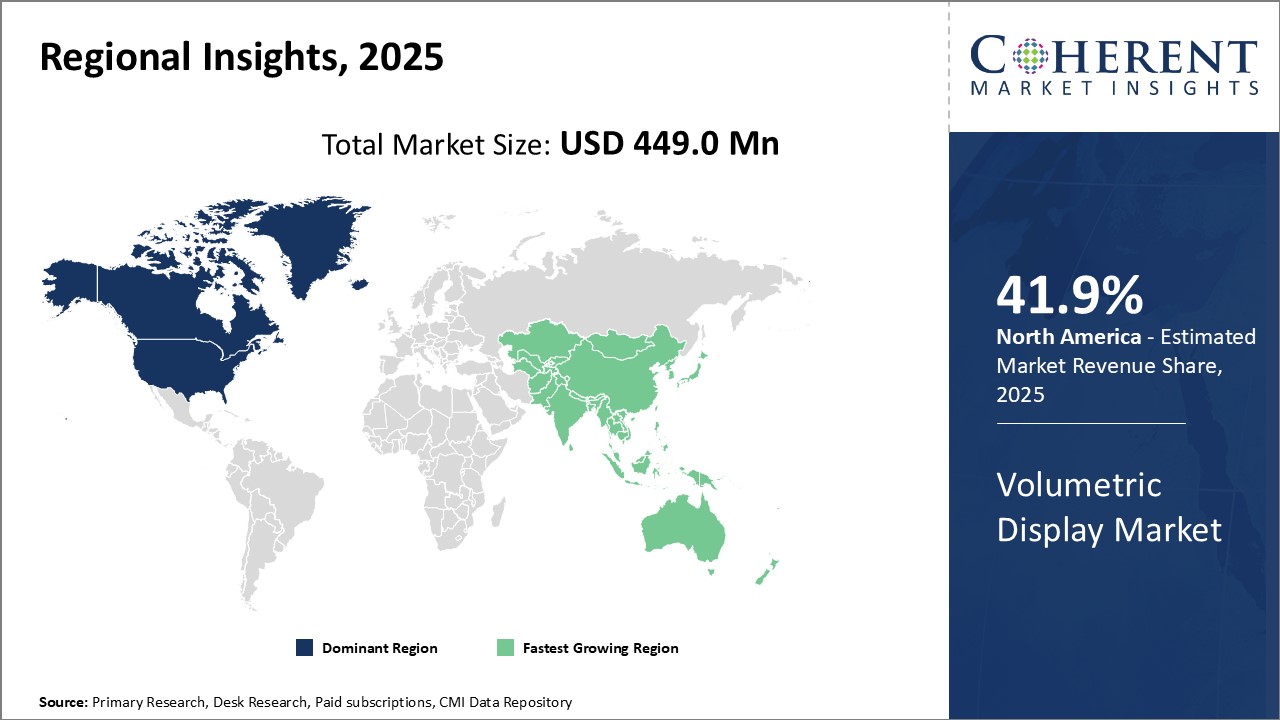
Need a Different Region or Segment? Download Free Sample
North America has established its stronghold as the dominant region in the global volumetric display market. The region is estimated to hold the market share of 41.9% in 2025. With early adoption of new technologies and strong presence of innovative industry players, the region has spearheaded the development of volumetric display solutions. Countries like the U.S. and Canada have remained on the forefront of research and development in this field. Backed by generous government funding and grant programs, North American universities and research labs have been conducting pioneering work. Many of the fundamental technology breakthroughs originates from these institutes. Additionally, the region is home to major display manufacturers which has helped in commercialization of products. Strong manufacturing capabilities along with focus on intellectual property rights also make North America an attractive destination for Volumetric display companies.
The Asia Pacific region has emerged as the fastest growing market for volumetric displays globally. Taiwan, South Korea, China, Japan and few Southeast Asian countries are fueling this growth. Countries like China and Japan already have a robust electronics industry ecosystem which is enhancing technology adoption. Component manufacturers based in these markets are actively engaged in product development. Further, low production costs and supportive trade policies have begun to attract global volumetric display OEMs (original equipment manufacturers) to establish manufacturing facilities in the region. This is positively impacting imports and exports. The huge consumer market in APAC along with growing applications in healthcare and education are strong demand drivers. The regional players are emphasizing on cost competitive offerings to target price-sensitive emerging countries.
Market Report Scope
Volumetric Display Market Report Coverage
| Report Coverage | Details | ||
|---|---|---|---|
| Base Year: | 2024 | Market Size in 2025: | USD 449.0 Mn |
| Historical Data for: | 2020 To 2024 | Forecast Period: | 2025 To 2032 |
| Forecast Period 2025 to 2032 CAGR: | 24.6% | 2032 Value Projection: | USD 2,094.5 Mn |
| Geographies covered: |
|
||
| Segments covered: |
|
||
| Companies covered: |
Coretec Group Inc., Lightspace Labs, Voxon Photonics, Holografika kft., Holoxica Ltd, Leia Inc., SEEKWAY, Looking Glass , Burton Inc., Alioscopy |
||
| Growth Drivers: |
|
||
| Restraints & Challenges: |
|
||
Uncover macros and micros vetted on 75+ parameters: Get instant access to report
Market Segmentation
- Display Type Insights (Revenue, USD Mn, 2020 - 2032)
- Swept Volume Display
- Static Volume Display
- Application Insights (Revenue, USD Mn, 2020 - 2032)
- Medical
- Aerospace & Defense
- Automotive
- Media & Entertainment
- Education
- Others
- Regional Insights (Revenue, USD Mn, 2020 - 2032)
- North America
- U.S.
- Canada
- Latin America
- Brazil
- Argentina
- Mexico
- Rest of Latin America
- Europe
- Germany
- U.K.
- Spain
- France
- Italy
- Russia
- Rest of Europe
- Asia Pacific
- China
- India
- Japan
- Australia
- South Korea
- ASEAN
- Rest of Asia Pacific
- Middle East & Africa
- GCC
- Israel
- South Africa
- Rest of Middle East & Africa
- North America
- Key Players Insights
- Coretec Group Inc.
- Lightspace Labs
- Voxon Photonics
- Holografika kft.
- Holoxica Ltd
- Leia Inc.
- SEEKWAY
- Looking Glass
- Burton Inc.
- Alioscopy
Share
Share
About Author
Raj Shah is a seasoned strategy professional with global experience, from strategy to on-the-ground operational improvements. In last 13 years, he has executed number consulting projects focused on consumer electronics, telecom and consumer-internet business leading multiple long-term engagements towards mobilizing and executing on break-through strategy - leading to tangible sales results. Raj is also acting as a strategy consultant for one of the leading online hyper local service providers in India, contributing to their growth through critical strategic decisions. Raj usually spends time after office in talking to the passionate entrepreneurs, regardless of their funding status.
Missing comfort of reading report in your local language? Find your preferred language :
Transform your Strategy with Exclusive Trending Reports :
Frequently Asked Questions
EXISTING CLIENTELE
Joining thousands of companies around the world committed to making the Excellent Business Solutions.
View All Our Clients
